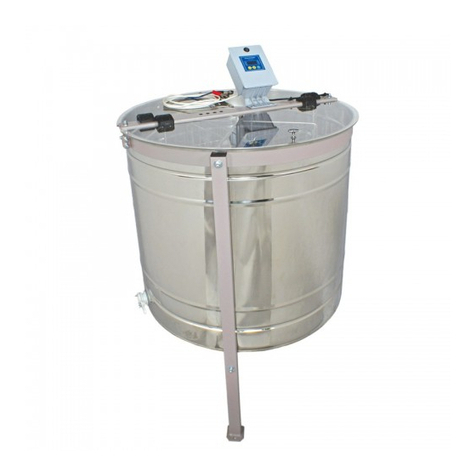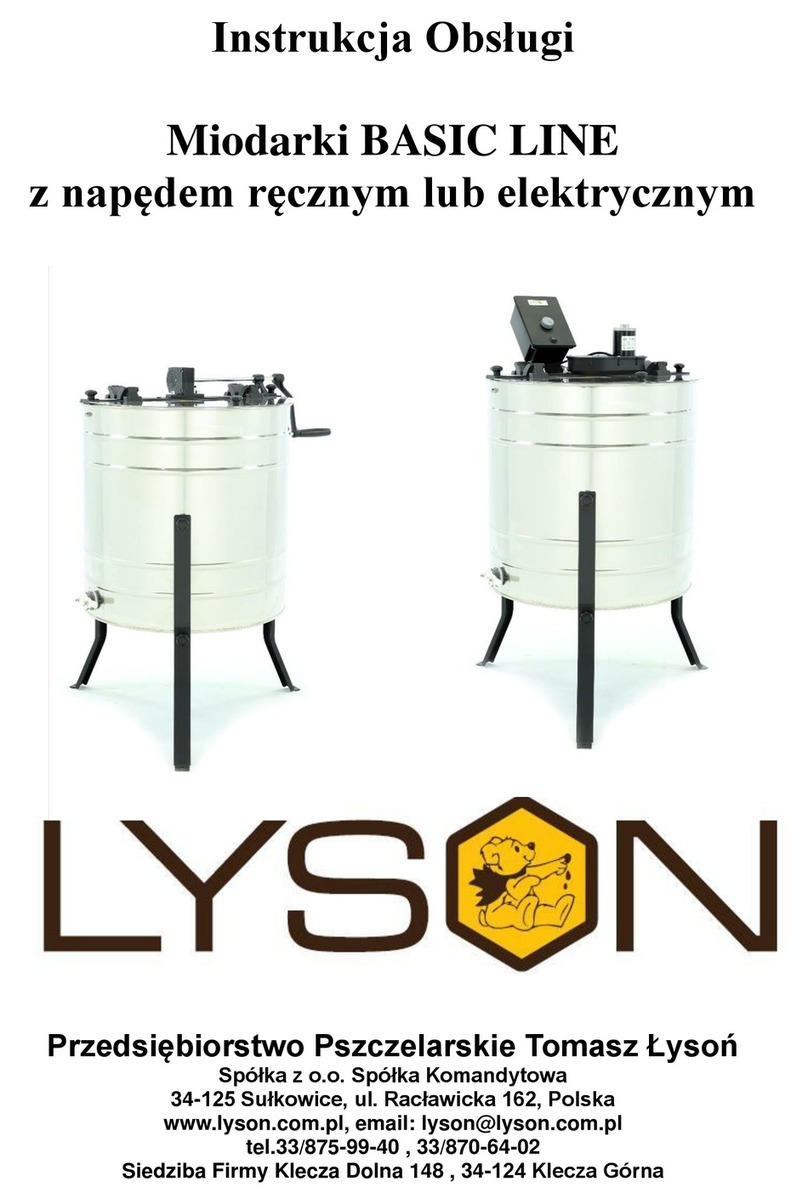1. General safety operational principles for the
honey extractor
Prior to device usage initiation, refer to the following
manual and act according the guidelines contained
therein. The manufacturer shall not be held accountable
for any damages caused by improper usage of the
device or its improper handling
1.1. Operational principles
1. The honey extractor is intended to centrifuge the honey
from the frames .
2. The honey extractor must be washed thoroughly prior to
usage with water containing slight amount of agents
admissible to be used in cleaning the devices coming into
contact with food or by means of a pressure washer,
remember to protect the electronic components and
bearings against damping !!!
Honey extractors with 12V controller must not be
conected to a power supply from a rectifier as it may
damage the controller.
The aforementioned damage is not included in the
guarantee.
Battery of a feeder from “Łysoń” company
remains a proper source of power.
1.2. Electrical safety
1. If non-detachable power supply cable gets damaged
and must be replaced, it must be performed at a
guarantor’s or by a specialised repair centre or by a
qualified person in order to avoid any threat.
2. Do not operate the honey extractor when the power
supply cable is damaged.
3. Prior to plugging in the device to the mains, check
whether controller is switched off. 0/1 switch on the
controlling panel should be in “0” position .
4. Check the honey extractor and the power source for
nominal voltage compliance (battery of feeder from
Łysoń company).
1. Be careful while connecting the device to the mains.
Hands must be dry!
5. The floor on which the extractor has been placed must
be dry!
6. The honey extractor lid must be closed during
spinning!. It is forbidden to open the lid during spinning.
7. While spinning, the honey extractor must not be
displaced.
8. The engine and the controller must be protected
against damping; ( also during the storage).
9. It is forbidden to pull the supply cable. The supply
cable must be kept away from heat sources, sharp
edges and its good technical state must be taken care
of.
1.3. Operational safety
1. The following equipment is not intended to be
used by persons with limited physical, sensory
or mental capabilities (including children) or
persons inexperienced or unfamiliar with that
type of equipment unless the usage occurs
under supervision or in line with the equipment
operating manual provided by safety
supervising persons. One must make sure that
children do not play with the honey extractor.
2. In case of any damage to the honey extractor,
in order to avoid the danger, the repairs may be
performed solely by a specialist servicing
centre or a qualified person.
3. It is forbidden to perform any maintenance
works or repairs when the device is in
operation.
4. Honey extractor may restarted once the
danger has been eliminated.
5. The device cannot be activated and stored with
the ambient temperature below 0º C.
Honey extractor cannot be activated when the
ambient temperature drops below 5º C. When
the honey extractor has been moved from a
room with a lower temperature to a room with a
higher temperature, prior to its activation one
must wait until the device has achieved the
ambient temperature.
It is forbidden to make any repairs while the device is
under operation
It is forbidden to remove any shields while the device is
under operation
2. Honey extractor manual
2.1 General principles for preparing the honey
extractor for operation
1. Place the honey extractor in the place specified for the
purpose and kept in order and cleanliness
2. Fix the honey extractor to the ground in order to avoid
its displacement during spinning.
2.2 Operating principles
1. Honey extractor is intended to centrifuge the honey
from the frames.
2. Prior to extraction, the honey extractor must be
washed thoroughly in line with the guidelines
contained in the chapter Honey extractor
maintenance.
3. While washing, take special precautions to prevent





























